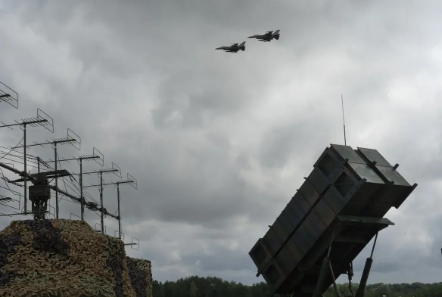Ukraine’s air defenses are facing new challenges as Russia changes the way it fires its missiles. The U.S.-made Patriot missiles, once seen as nearly unbeatable, are now finding it harder to stop some of Russia’s latest ballistic weapons. These changes are not about quantity but about how Russia’s missiles are now moving during flight.
Patriot Missiles Under Pressure in Ukraine’s Defense
Traditionally, ballistic missiles follow a fixed path after being launched. Once in the air, they rise high and then fall quickly toward their targets. This predictable movement allows defense systems like the Patriot missiles to calculate where the missile will land and intercept it mid-flight. But now, Russia’s missiles are no longer following the same simple path.
They are being launched on what experts call “quasi-ballistic trajectories.” This means they start like regular ballistic missiles but then shift direction or change speed later in the flight. These sudden moves make it very hard for Patriot missiles to calculate where and when to intercept them. The system relies on automatic tracking to destroy incoming threats, and when a missile changes its direction mid-air, even a few degrees can throw off the interception attempt.
📦 Germany denies Patriot missile delivery to Ukraine as defense world scrambles for answers
As a result, Ukraine’s air defense units now find it “more difficult” to bring down incoming missiles. Reports say that only one of the two Russian ballistic missiles fired in a recent attack was successfully intercepted. This marks a worrying trend in a war where air defense is one of Ukraine’s most important shields.
Russia Adapts Its Missile Strategy
Russia’s missile attacks on Ukraine have not only become more frequent but also more advanced. Over the weekend, Ukraine was struck by around 500 drones, over 50 cruise missiles, and two ballistic missiles. These numbers show that Russia is combining different kinds of weapons to overwhelm defenses and challenge the Patriot missiles.
According to recent reports, Russian engineers have upgraded missiles like the Iskander-M and Kinzhal. These missiles can now change direction mid-flight, confusing defense radars and interceptor missiles. Some can also enter a “terminal dive” — the final phase of their flight — at unusual angles or speeds. This unpredictable motion helps them slip past radar systems and avoid interception by Patriot missiles.
The air-launched Kinzhal missile, also called “Dagger,” travels several times faster than the speed of sound and is known for its speed. Engineers have also adjusted the ground-launched Iskander-M to mimic similar unpredictable movement. These upgrades allow missiles to approach targets from unexpected directions, often at low altitudes or with sudden shifts in course — making interception by Patriot missiles even harder.
Oleh Kolesnikov: From Ukrainian Patriot to Russian Spy
In the past few months, these tactics have damaged key infrastructure sites, including energy and defense facilities. Reports suggest that around the capital region alone, several drone and missile production sites have been hit by such attacks. These strikes show how Russia is using its new missile behavior to test and find weaknesses in Ukraine’s layered air defense systems that include Patriot missiles.
Every time Russia changes its tactics, it learns how Ukraine’s systems respond. While this helps Ukraine gather information to improve its defenses, it also allows Russia to fine-tune its own missile strategies. The situation has turned into a constant cycle of adaptation and response between the two sides.
Patriot Missiles: Limited but Crucial Defense
For Ukraine, the Patriot missiles remain one of its most valuable tools. Built in the United States, they are considered among the most advanced air defense systems in the world. They can detect, track, and intercept multiple types of incoming missiles — including ballistic, cruise, and even some hypersonic ones.
However, Patriot missiles and their launch systems are limited in number. Each battery covers only a specific area, and Ukraine has only a few of them in operation. Protecting an entire city requires several systems positioned in different locations, each with its own radar coverage. When missiles come from different directions, one system alone cannot detect and respond to all of them.
The interceptor missiles used by the Patriot missiles are also expensive and take time to replace. This makes every launch a costly decision. When facing a mix of drones, cruise missiles, and ballistic weapons, Ukraine’s defense teams must decide which threats to prioritize.
Recent reports from defense agencies have confirmed that Russia’s new missile flight patterns have made interception harder. Between April and June this year, assessments noted that Ukrainian forces “struggled to consistently” use Patriot missiles against these improved Russian ballistic missiles.
🚨 U.S. intel: Patriot air defense crumbles as Russian missiles outmaneuver interceptors
The challenge is not only technological but also strategic. Each time Russia launches an attack using unpredictable flight paths, Ukraine’s defenses must work faster and smarter to adjust. The Patriot missiles automation system predicts and responds instantly, but unpredictable motion forces it to perform calculations that stretch its capabilities.
The result is a more dangerous sky for Ukraine. Missiles that can twist, dive, or shift mid-flight give attackers an edge, while defenders must rely on quick detection and limited equipment to respond. Despite these challenges, Patriot missiles remain Ukraine’s main defense against ballistic missiles, forming the backbone of its shield against complex Russian attacks.
